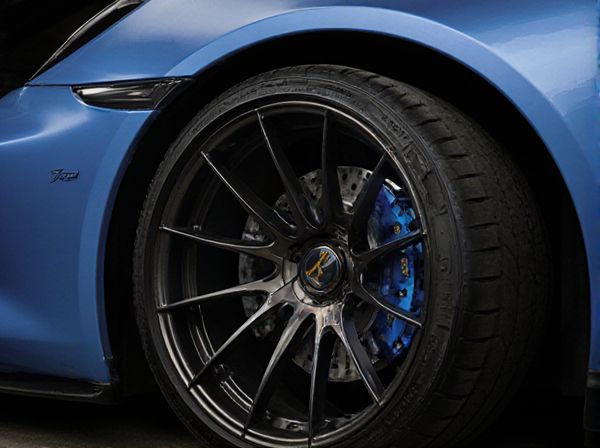
Photo illustration: Forged vs Cast
Forged components exhibit superior strength and durability compared to cast parts due to the metal's grain structure alignment during forging. Casting allows for complex shapes and intricate details, making it ideal for intricate designs but potentially less robust under high stress. Your choice between forged and cast materials depends on the application's strength requirements and design complexity.
Table of Comparison
| Feature | Forged Wheels | Cast Wheels |
|---|---|---|
| Manufacturing Process | High-pressure forging of solid aluminum billet | Molten aluminum poured into molds |
| Strength | Higher tensile strength and durability | Lower strength, more prone to cracks |
| Weight | Lighter due to denser metal structure | Heavier because of grain structure |
| Cost | Premium pricing due to complex process | More affordable and mass-produced |
| Performance | Better handling and acceleration | Standard performance, adequate for daily use |
| Customization | Highly customizable with precise designs | Limited design flexibility |
| Repairability | Easier to repair after damage | Difficult to repair, often requires replacement |
Understanding Forged and Cast Manufacturing Processes
Forged manufacturing involves shaping metal through localized compressive forces, resulting in enhanced strength and grain structure, ideal for high-stress applications. Cast manufacturing pours molten metal into molds, allowing complex shapes and large components but with variable mechanical properties due to potential porosity and solidification defects. Choosing between forged and cast parts depends on performance requirements, cost considerations, and production complexity.
Key Differences Between Forged and Cast Materials
Forged materials exhibit superior strength and durability due to the metal grain structure being compressed and aligned during the forging process, enhancing mechanical properties such as tensile strength and fatigue resistance. In contrast, cast materials are produced by pouring molten metal into molds, leading to a more uniform shape but often containing internal porosities and grain boundaries that can reduce overall strength and impact resistance. Forging typically results in higher-quality components used in critical applications like aerospace and automotive industries, while casting is favored for complex geometries and cost-effective production of large parts.
Strength and Durability Comparison
Forged components exhibit higher strength and durability due to the grain structure being aligned during the forging process, which enhances resistance to impact and fatigue. Cast parts, formed by pouring molten metal into molds, tend to have a more brittle microstructure with potential porosity, leading to reduced mechanical strength and susceptibility to cracks under stress. Industrial applications demanding superior toughness and long-term reliability often favor forged materials for critical load-bearing components.
Weight Considerations: Forged vs Cast
Forged components typically offer superior strength-to-weight ratios compared to cast parts, allowing for lighter designs without compromising durability. Cast parts tend to be heavier due to the nature of the casting process, which can introduce internal porosity and require thicker sections for strength. Weight considerations are critical in automotive and aerospace applications where forged materials enhance performance by reducing overall mass while maintaining structural integrity.
Cost Analysis: Forging vs Casting
Forging typically incurs higher initial tooling and operational costs due to the need for specialized dies and high-pressure equipment, but it often results in superior mechanical properties that reduce long-term maintenance expenses. Casting offers lower upfront costs with more flexible mold designs and is ideal for complex geometries, yet it may lead to higher defect rates and additional machining expenses. Evaluating cost-effectiveness requires balancing the volume, material type, mechanical performance, and post-processing requirements of each manufacturing method.
Common Applications of Forged Components
Forged components are widely used in automotive and aerospace industries for critical parts such as crankshafts, connecting rods, and turbine blades due to their superior strength and fatigue resistance. These components are also essential in heavy machinery and construction equipment where high durability and impact resistance are required. Common applications include gear blanks, aircraft landing gear, and pressure vessels, where precision and reliability under extreme conditions are crucial.
Typical Uses for Cast Products
Cast products are commonly used in automotive engine blocks, pump housings, and heavy machinery components due to their ability to form complex shapes and large sizes economically. Foundries produce castings for architectural hardware, pipe fittings, and valve bodies where strength and durability are crucial. The casting process supports mass production of parts requiring intricate internal geometries, making it ideal for aerospace and marine applications.
Performance in Extreme Conditions
Forged components exhibit superior performance in extreme conditions due to their enhanced grain structure and increased density, which provide higher tensile strength and better impact resistance compared to cast parts. Cast components, while cost-effective and capable of complex shapes, often have porosity and inclusions that reduce durability under high stress or temperature variations. In high-pressure or high-temperature environments, forged parts maintain structural integrity and fatigue resistance, making them the preferred choice for aerospace, automotive, and heavy machinery applications.
Visual and Structural Characteristics
Forged parts exhibit a more uniform grain structure with aligned fibers that enhance strength and durability, while cast components often contain porosity and inconsistent grain patterns, leading to weaker points. Visually, forged items display smoother surfaces with minimal flash marks, contrasting with the rougher, more irregular texture and visible seams or parting lines found on cast pieces. The structural integrity of forged materials allows for improved fatigue resistance and impact toughness compared to the brittle nature commonly associated with cast metals.
Choosing the Right Option: Forged or Cast
Choosing between forged and cast components depends on factors such as strength requirements, design complexity, and budget. Forged parts offer superior mechanical properties and durability, making them ideal for high-stress applications like automotive and aerospace industries. Cast components provide greater design flexibility and cost-effectiveness, suitable for intricate shapes and low to medium-stress uses.
 caratoz.com
caratoz.com